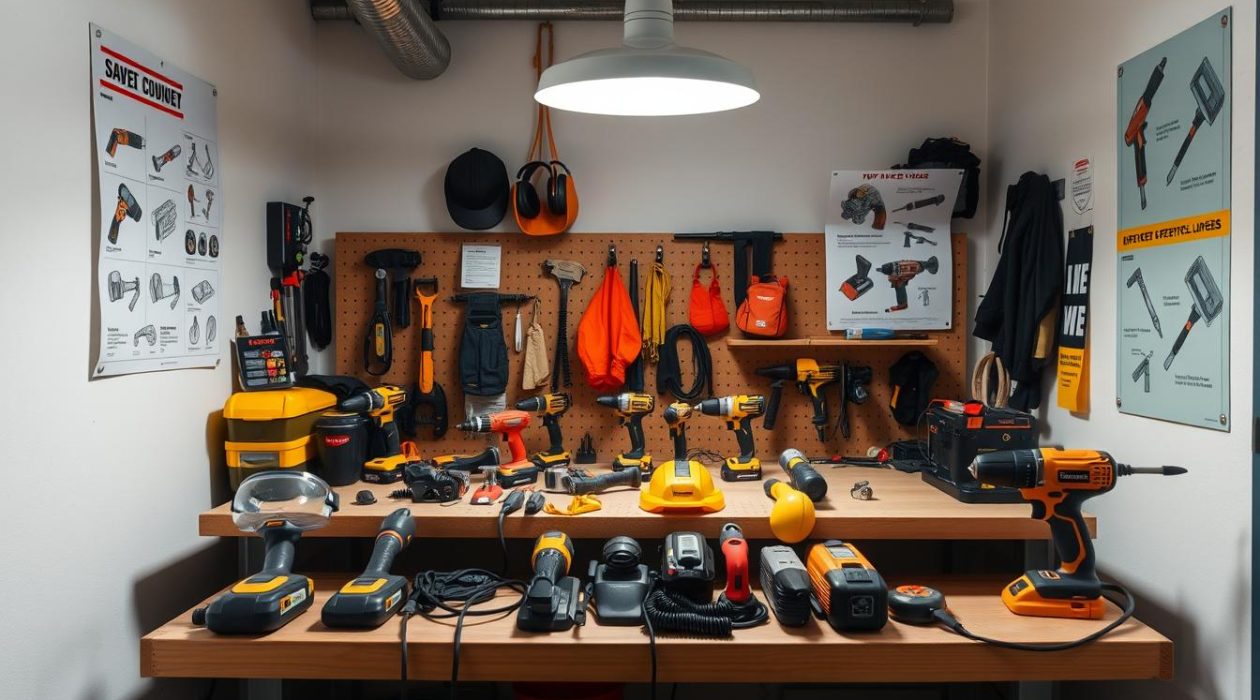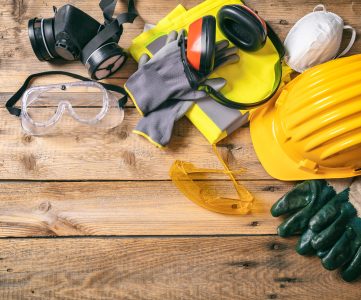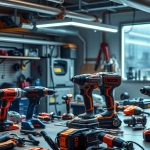Working with power tools demands a focus on safety to avoid accidents. It’s critical to follow safety guidelines and best practices. This ensures the tools are used correctly and safely.
For beginners, grasping the basics of power tool safety is key. This includes the right use of safety gear and regular tool upkeep. Adhering to these safety tips helps reduce injury risks and promotes safe tool use.
Emphasizing safety in power tool use fosters a secure work environment and deters accidents. It’s crucial to remain updated on safety guidelines and practices. This ensures the safe operation of power tools.
Key Takeaways
- Power tool safety tips are essential for preventing accidents and ensuring safe usage.
- Proper use of safety equipment is crucial for power tool safety.
- Regular maintenance is vital for ensuring power tool safety and safe usage.
- Understanding power tool safety tips and best practices can minimize the risk of injury.
- Creating a safe working environment is critical for power tool safety and safe usage.
- Staying informed about power tool safety tips and best practices is essential for safe usage of power tools.
Understanding Power Tool Safety Fundamentals
For those engaging in safe DIY projects, grasping power tool safety basics is essential. Power tools can pose risks if not used correctly. It’s vital to understand these dangers to avoid accidents and ensure a safe workspace.
Power tool safety covers various aspects, including basic safety rules, common hazards, and safety ratings. Knowing about safety ratings helps DIYers pick the right tools for their projects. This knowledge is crucial for safe DIY projects and preventing hazards.
Basic Safety Principles
Basic safety principles form the core of power tool safety. This includes wearing protective gear like safety glasses and gloves. It’s also important to keep the workspace clear and follow the tool’s manufacturer instructions. Regularly checking tools for damage is another key step.
Common Power Tool Hazards
Common hazards with power tools include electrical shock, cuts, and entanglements. To reduce these risks, use tools in well-ventilated areas and avoid overreaching. Keeping loose clothing tied back and being mindful of your surroundings also helps prevent accidents.
Safety Ratings and Classifications
Safety ratings and classifications help choose the right power tools. These ratings consider the tool’s power, speed, and potential hazards. Understanding these can help DIYers make safer choices for their safe DIY projects.
Understanding power tool safety fundamentals is key to completing safe DIY projects with confidence. Always follow basic safety rules, be aware of hazards, and select tools with suitable safety ratings. With this knowledge, DIY enthusiasts can work safely and avoid risks associated with power tools.
Essential Personal Protective Equipment (PPE)
When it comes to beginner tool safety, the right personal protective equipment (PPE) is key. PPE prevents injuries and ensures a safe workspace. Safety glasses, earplugs, and gloves are among the must-haves.
Choosing the right PPE for the task is vital. For instance, when dealing with power tools that kick up dust or debris, safety glasses with a wraparound frame are crucial. They protect your eyes from all sides. Earplugs are also necessary to shield your hearing from loud tools.
A list of essential PPE items includes:
- Safety glasses
- Earplugs
- Gloves
- Steel-toed boots
- Dust mask
Remember, personal protective equipment is not just a suggestion; it’s a must when using power tools. Wearing the correct PPE greatly reduces injury risk and ensures a safe work environment.
As a beginner, understanding the role of PPE in injury prevention and safety is crucial. By adhering to these guidelines and using the right PPE, you can stay safe and focus on your work.
| PPE Item | Description |
|---|---|
| Safety Glasses | Protects eyes from dust and debris |
| Earplugs | Protects hearing from loud noises |
| Gloves | Protects hands from cuts and abrasions |
Proper Power Tool Storage and Maintenance
Proper storage and maintenance of power tools are key to safety. They prevent accidents, keep tools in top condition, and extend their life. Regular cleaning and checks can spot issues early, avoiding bigger problems later.
Important aspects of power tool storage and maintenance include:
- Cleaning and inspection routines to prevent damage and wear
- Storage best practices to keep tools organized and secure
- Maintenance schedule guidelines to ensure tools are in good working condition
By adhering to these safety tips, individuals can avoid accidents and keep their tools ready for use. Effective storage and maintenance are vital for power tool longevity and performance.
It’s also crucial to follow the manufacturer’s guidelines for storage and maintenance. This ensures power tools are handled and maintained correctly, lowering the risk of accidents and injuries.
Creating a Safe Workspace Environment
When tackling safe DIY projects, the workspace environment is crucial. A well-organized and safe space can prevent accidents and ensure project success. Begin by evaluating the area for potential hazards.
A safe workspace environment requires proper lighting, ventilation, and electrical safety. Use sufficient lighting, ensure good airflow, and organize electrical cords and tools. Also, consider these tips for a safe workspace:
- Keep the workspace clean and clutter-free
- Use protective gear, such as safety glasses and gloves
- Ensure all power tools are in good working condition
By adhering to these guidelines, you can reduce accident risks and achieve a successful safe DIY project. Always prioritize your safety and the safety of those nearby.
Power Tool Safety Features and Functions
Understanding the safety features and functions of power tools is essential for beginner tool safety. These elements are designed to prevent accidents and ensure a safe workspace. A key feature is the safety guard, which prevents accidental contact with the tool’s cutting edge or other moving parts.
Another vital feature is the emergency shut-off system. It allows users to quickly stop the tool in emergency situations. This is crucial for cordless tools, which are more accident-prone due to their portability. Battery safety for cordless tools is also critical, as improper handling can cause fires or explosions.
Some key safety features and functions to look for in power tools include:
- Automatic shut-off
- Soft-start technology
- Overload protection
- Thermal cut-off
These features help prevent accidents and ensure a safe working environment. By understanding and using these safety features and functions, users can reduce injury risks and achieve successful project outcomes.
| Power Tool | Safety Feature | Description |
|---|---|---|
| Circular Saw | Safety Guard | Prevents accidental contact with the blade |
| Drill | Emergency Shut-off | Allows for quick shutdown in case of an emergency |
| Cordless Tool | Battery Safety | Prevents fires or explosions due to improper battery handling |
By prioritizing beginner tool safety and understanding power tool safety features, users can create a safe and productive workspace.
Safe Operating Techniques for Common Power Tools
Working with power tools requires adherence to power tool safety tips to avoid accidents. Understanding the correct operating techniques for each tool is crucial. This includes drills, saws, and sanders, which are staples in many projects.
To operate safely, consider these guidelines:
- Always read the manual before using a power tool
- Wear proper personal protective equipment, such as safety glasses and gloves
- Keep loose clothing and long hair tied back to avoid entanglement
- Use the correct bit or blade for the specific task
By adhering to these power tool safety tips and operating techniques, you can greatly reduce injury risks. Always remain focused and alert when using power tools. Never operate them when tired or under the influence.
Regular inspection and maintenance of your power tools are also essential. This includes cleaning, lubricating, and checking for damage or wear. By combining proper operating techniques with regular maintenance, you can ensure a safe and productive experience with your power tools.
| Power Tool | Safety Precaution |
|---|---|
| Drill | Use a drill bit that is suitable for the material being drilled |
| Saw | Keep fingers away from the blade and use a push stick when necessary |
| Sander | Wear a dust mask and safety glasses to protect against debris |
Electrical Safety and Power Management
Working on DIY projects requires careful attention to electrical safety and power management. This is crucial to avoid accidents and maintain a safe workspace. Understanding electrical safety and effective power management is key to preventing electrical mishaps.
Electrical safety and power management involve several critical aspects. These include the use of extension cords, ground fault circuit interrupters (GFCIs), and careful consideration of voltage. For instance, using extension cords correctly is vital to prevent electrical accidents. GFCIs also play a significant role in protecting against ground faults.
Extension Cord Safety
Ensuring the safe use of extension cords is fundamental to DIY projects. It’s important to select the appropriate extension cord for the task, avoid overloading, and keep cords away from water and heat sources.
Ground Fault Circuit Interrupters (GFCIs)
GFCIs are crucial for electrical safety and power management. They help prevent ground faults and electrical accidents. Knowing how GFCIs function and how to install them is essential for a safe working environment.
Voltage Considerations
Voltage is another critical factor in DIY projects. Using the wrong voltage can lead to electrical accidents. It’s important to understand voltage requirements and use the right power tools to ensure electrical safety and prevent accidents.
By adhering to electrical safety and power management guidelines, individuals can create a safe working environment. Electrical safety is a fundamental aspect of power tool safety. Understanding how to manage power effectively is essential for a successful and safe DIY project.
Emergency Response and First Aid Protocols
Working with power tools demands readiness for emergencies. Beginner tool safety is key to avoiding accidents. Yet, knowing how to react in an emergency is equally vital. In injury cases, every second is crucial, and having a plan can be life-saving.
First aid is a cornerstone of emergency response. It encompasses wound care, shock treatment, and other critical actions. It’s essential to have a first aid kit ready and to understand its contents. Key items for a first aid kit include:
- Bandages and band-aids
- Antiseptic wipes and spray
- Pain relievers and antihistamines
- Medical tape and scissors
Having a first aid kit is just the start. Knowing emergency procedures is equally important. This includes calling 911, providing basic life support, and remaining calm. Being prepared and knowing how to act in emergencies ensures a safe work environment and prevents accidents from escalating.
Remember, beginner tool safety and emergency response are intertwined. By learning about safety protocols and emergency procedures, you can prevent accidents and maintain a safe work environment.
Conclusion: Making Power Tool Safety a Priority
As you start your next project with power tools, safety must be your first concern. Adhering to the key tips and practices discussed here ensures a safe and successful outcome. It’s vital to know the basic safety rules, wear the right protective gear, and keep your tools in good condition.
Setting up a safe workspace, understanding your tools’ safety features, and using them correctly are essential. Electrical safety and being ready for emergencies are also critical. A bit of caution and focus can significantly enhance safety for you and your project area.
By prioritizing power tool safety, you not only safeguard yourself but also encourage others to do the same. This fosters a safety-conscious environment, allowing DIY enthusiasts to work confidently and worry-free. Always remember to review safety guidelines before using power tools, ensuring safety is your guiding principle.



